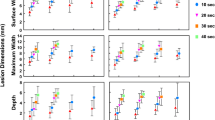Abstract
A prototype steerable 8.5F bipolar catheter fitted with a feedback thermocouple was tested in 7 anaesthetized pigs (30 kg) guided by the electrocardiogram in order to modify the AV nodal and His-Purkinje system conductive properties. Thermal energy was delivered by a pressurized N
2O tank (>650 psi) via a cardiac cryo unit (Spembly, Hampshire, UK) into the catheter wherein gas expands resulting in a tip temperature as low as
−70
± 2°C within 10 seconds. Cryoablation under fluoroscopic and electrocardiographic guidance was applied at distinct sites in both ventricles for 60 or 120 seconds. After a follow-up period of 6 weeks, the ablation lesions found were well demarcated with small margins of hypertrophy of myocardial cells. With respect to lesion volume variability (8–207 mm
3) and geometry, a relationship between the 0°C isothermic period and cryolesion volume was found. Results of an in vitro model corroborated this relationship. Therefore, an isothermic period probably can predict the lesion size and its geometry in terms of lesion depth. This potential therapeutic mode of transcatheter cryoablation deserves further investigation.
Similar content being viewed by others
References
Jackman WM, Wang X, Friday KJ, et al. Catheter ablation of accessory AV pathways (Wolff-Parkinson-White syndrome) by radiofrequency current.N Engl J Med1991;324: 1605-1611.
Calkins H, Sousa J, El-Atassi R, et al. Diagnosis and cure of the Wolff-Parkinson-White syndrome or paroxysmal supra-ventricular tachycardias during a single electrophysiological test. N Engl J Med1991;324:1612-1618.
Kuck KH, Schluter M, Geiger M, Siebels J, Dukeck W. Radiofrequency current catheter ablation of accessory atrioventricular pathways. Lancet 1991;337:1557-1561.
Lesh MD, Van Hare GF, Schamp DJ, et al. Curative percutaneous catheter ablation using radiofrequency energy for accessory pathways in all locations: Results in 100 consecutive patients. J Am Coll Cardiol 1992;19:1303-1309.
Lee MA, Morady F, Kadish A, et al. Catheter modification of the atrioventricular junction with radiofrequency energy for control of atrioventricular nodal reentry tachycardia. Circulation 1991;83:827-835.
Jackman WM, Beckman KJ, McClelland JH, et al. Treatment of supraventricular tachycardia due to atrioventricular nodal reentry by radiofrequency catheter ablation of slow-pathway conduction. N Engl J Med1992;327:313-318.
Kay GN, Epstein AE, Dailey SD, Plumb VJ. Selective radiofrequency ablation of the slow pathway for the treatment of atrioventricular nodal reentrant tachycardia: Evidence for involvement of perinodal myocardium within the reentrant circuit. Circulation1992;85:1675-1688.
Jazayeri MR, Hempe SL, Sra JS, et al. Selective transcatheter ablation of the fast and slow pathways using radiofrequency energy in patients with atrioventricular nodal reentrant tachycardia. Circulation1992;85:1318-1328.
Klein LS, Shih H, Hackett FK, Zipes DP, Miles WM. Radiofrequency catheter ablation of ventricular tachycardia in patients without structural heart disease. Circulation 1992;85: 1666-1674.
Nakagawa H, Beckman KJ, McClelland JH, et al. Radiofrequency catheter ablation of idiopathic left ventricular tachycardia guided by a Purkinje potential. Circulation 1993;88: 2607-2617.
Chen SA, Chiang CE, Tai CT, et al. Complications of diagnostic electrophysiologic studies and radiofrequency catheter ablation in patients with tachyarrhythmias: An eightyear survey of 3,966 consecutive procedures in a tertiary referral center. Am J Cardiol 1996;77:41-46.
Gallagher LA, Sealy WC, Anderson W, et al. Cryo-surgical ablation of accessory atrioventricular connections:A method for correction of the pre-excitation syndrome. Circulation 1977;55:471-478.
Holman WL, Ikeshita M, Douglas JM, et al. Cardiac cryosurgery: Effects of myocardial temperature on cryolesion size. Surgery 1983;92:268-272.
Adkins CJ, ed. Equilibrium Thermodynamics, 3rd ed. Cambridge: Cambridge University Press, 1983.
Simson MB. Use of signals in the terminal QRS complex to identify patients with ventricular tachycardia after myocardial infarction. Circulation 1981;64:235-242.
Dennis AR, Richards DA, Farrow RH, Davison A, Ross DL, Uther JB. Technique for maximizing the frequency response of the signal averaged Frank vectocardiogram. J Biomed Engin 1986;8:207-212.
Peiffert B, Feldman L, Villemot JP, Verdier J. Cryochirurgie des tachycardies ventriculaires. Chirurgie 1992;118:137-143.
Fujino H, Thompson RP, Germroth PG, Harold ME, Swindle MM, Gillette PC. Histologic study of chronic catheter cryoablation of atrioventricular conduction in swine. Am Heart J 1993;125:1632-1637.
Misaki T, Allwork SP, Bentall HH. Long-term effects of cryosurgery in the sheep heart. Cardiovasc Res 1983;17: 61-69.
Rodriguez L-M, Leunissen J, Hoekstra A, et al. Transvenous cold mapping and cryoablation of the AV-node in dogs: Chronic observations of the lesions and comparison to those obtained with radiofrequency ablation. J Cardiovasc Electrophysiol 1998;9:1055-1061.
Author information
Authors and Affiliations
Rights and permissions
About this article
Cite this article
Hoekstra, A., de Langen, C..., Nikkels, P.G. et al. Prediction of Lesion Size Through Monitoring the 0°C Isothermic Period Following Transcatheter Cryoablation. J Interv Card Electrophysiol 2, 383–389 (1998). https://doi.org/10.1023/A:1009777024597
Issue Date:
DOI: https://doi.org/10.1023/A:1009777024597




